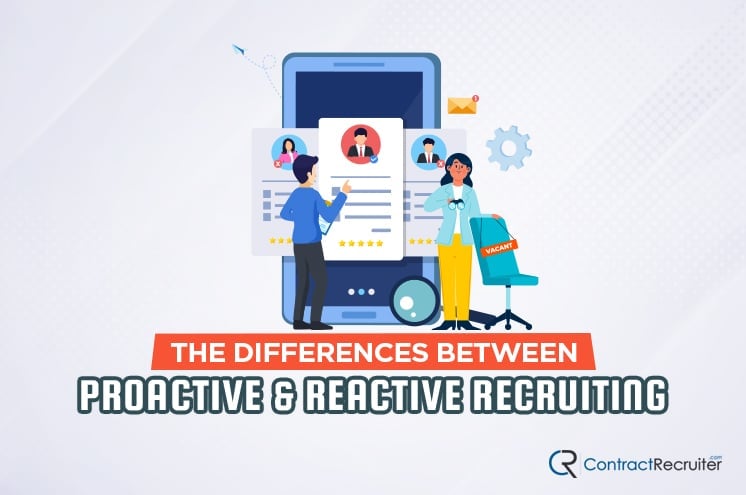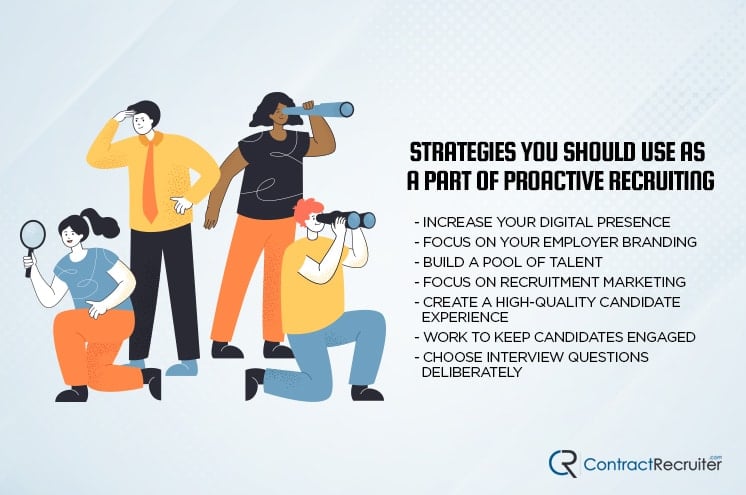In February 2022, both job openings and resignations were near record highs, while the rate of layoffs wasn’t far from a historic low. This phenomenon has been deemed “The Great Resignation,” with employees feeling confident that they can leave their current position for a better opportunity elsewhere.
With the job market still firmly an “employee’s market,” you might be wondering how you can alter your recruiting strategies to attract and retain the best talent out there.
One method you might consider is transforming your hiring process to be proactive rather than reactive. With proactive recruiting, you’re constantly building a pool of qualified candidates you can call upon when you have an open position. Reactive recruiting, on the other hand, is where you only start the search to fill a role at the same time it opens up.
Understanding the differences between proactive and reactive recruiting can have a significant impact on the quality of talent you attract, as well as your employee retention.
What Is Proactive Recruiting?
When your organization engages in proactive recruiting, it means you are basing your recruiting strategy on anticipating and preparing for change rather than being reactive to change. To do this, proactive recruiting requires that you are constantly monitoring the market and planning ahead.
Staffing changes are an inevitable part of any business. When you choose a proactive approach to recruitment, you are better equipped to deal with turnover. Additionally, when you want to ensure that you have a steady flow of candidates at all times, proactive recruiting strategies like being active in the talent community and marketing the brand can make a big difference.
Proactive recruiting doesn’t just mean that you can make replacing employees less stressful when the time comes. It also means that you will be more likely to acquire the best and brightest talent.
What Is Reactive Recruiting?
Many companies have a reactive recruiting practice. That means they only engage in the hiring process when actively searching for new employees. If your organization uses a reactive recruiting method, it can mean that your recruiter struggles to find suitable candidates within the urgent timeline.
In many companies, a vacant position emerges because an employee leaves the company or a department is expanding. Once this occurs, the job opportunity is posted on various channels. This will result in the hiring team receiving applications all at once, which must be screened. Then, recruiters will start the interview process with a short list of candidates.
Since there is an active vacancy, the hiring team is under tremendous pressure to hire a candidate from the pool of people that happened to apply to their post. As you might imagine, this can mean that recruiters are forced to select an unideal candidate or that a position is left vacant for longer than desirable because the hiring team is struggling to find someone suitable for the role.
What Are the Benefits of Proactive Recruiting?
There is a long list of reasons your organization might want to engage in proactive rather than reactive recruiting.
One of the major benefits is that it prevents the outcome of hiring the wrong candidate for a position simply because you need to fill the role. On the other hand, when you make a hiring decision too fast, it can mean that you have higher turnover rates at your company because either the employee or the management is unhappy with the placement.
When you engage in proactive recruiting, it gives both hiring teams and prospective candidates more time to get to know one another. This means that your recruiters can approach each candidate with a more relaxed attitude, determining whether or not they would be a good fit for the role specifically and the company overall.
It also means that candidates can have more time to determine whether or not they want to take on the responsibilities of the role they applied for. When candidates have the time and space they need to make an informed decision about a position, it can mean that you have happier employees that stick around longer.
Another benefit of proactive recruitment is that it can help you save time when you need to fill a role at your organization. Rather than only recruiting on an as-needed basis, your hiring team will be working year-round to create a list of pre-sourced and screened candidates that make up your talent pool.
When you have an opening at your company, you don’t have to take the time to design a job description, publish them on all of the most popular job listing sites, and review a massive pile of resumes in a short time. Instead, you can look through your list of candidates and reach out to the individuals you’d like to interview for the position.
Proactive recruiting can also help you get a better grasp of the market. Proactive recruiting lets your hiring team make contact with the best of the best when it comes to talent in your field. You can use marketing strategies like newsletters, email campaigns, social media campaigns, and more, to build a talent community you can call upon when a new position opens up at your organization.
Whether you use a proactive or a reactive method for recruiting new candidates for your organization, it’s essential to have a clear understanding of the “Candidate Journey” implied in your process. This recent post looks at a candidate journey map and why your organization should have one.
What Are the Disadvantages of Reactive Recruiting?
As you might imagine, there are several disadvantages to having a reactive recruiting strategy.
For example, reactive recruiting is a lot more time-consuming than proactive recruiting. That might seem counterintuitive because proactive recruiting is a year-round activity, while reactive recruiting is something you only engage in when you need to.
However, your hiring team will probably have to start from scratch every time you need to fill a position when you are reactive rather than proactive. Generally, the hiring process usually takes six to twelve weeks from posting the job online to offering the position to a candidate.
This can be seriously costly to your business if the position is unfilled during that time. You might even find that you have to hire contract employees to fill it while you are searching for the ideal candidate to take on the role.
Because of the costs to your company, your hiring team might feel a lot of pressure to fill the position immediately. However, they can’t afford to wait around for the perfect person to send in their resume, so they have to choose from the pool of people that happened to reply to their posting.
The reality is, though, that choosing an unideal candidate for a role can be incredibly costly for your organization. According to some statistics, the average cost of a poor hiring decision is almost $15,000.
Reactive recruiting simply doesn’t allow your organization the time and space it needs to make a decision that everyone feels good about. If you’ve been using a reactive strategy when it comes to hiring, you surely have learned that sometimes you luck out with the candidate pool, and other times you feel like you’re just grasping at straws.
What Strategies Should You Use as a Part of Proactive Recruiting?
With a competitive playing field in the world of talent acquisition, it’s essential to be ahead of the game when it comes to recruitment. Here are some strategies you can employ as a part of your proactive recruitment process.
1. Increase Your Digital Presence
Enhancing your online presence is a crucial aspect of turning your recruitment process into a proactive method rather than a reactive one. You want the types of candidates you see as ideal to be able to find your brand easily.
Consider creating a content strategy to help ensure that you become a familiar name amongst your ideal talent pool. Doing so will let candidates see that you’re a leader in the industry and increase the likelihood that they will be eager to join your organization if the opportunity arises.
2. Focus on Your Employer Branding
It’s important to carefully curate and craft the way that your vision, ethos, mission, and culture are represented on your site and elsewhere online. This is an essential part of your brand’s identity and can mean the difference between finding the ideal candidate and settling for someone who doesn’t appear to be the best fit for the role.
3. Build a Pool of Talent
Any time you find a candidate that could be a good fit for your company down the road, you’ll want to record and file their information so that you can call upon it in the future. Proactive recruiting means you always have your eyes open for prospective candidates, even when you aren’t actively looking to hire anyone.
The bigger your talent pool, the less you will have to rely on reactive strategies like selecting a candidate from applications resulting from a job posting.
4. Focus on Recruitment Marketing
An essential part of your recruitment strategy is having an attractive career page that is easy to find from your home page. You can use this page as an opportunity to share your brand’s values and culture with people who might be interested in working for your organization.
You can also develop strategies to encourage your current employees to share their experiences with the company on sites like LinkedIn and Glassdoor.
If you’re considering transitioning to a proactive recruitment process from a reactive one, you’ll also want to learn the difference between passive and active candidates. Check out this article to learn more.
5. Create a High-Quality Candidate Experience
When engaging in proactive recruiting, you want to encourage as many people as possible to share their information with your brand. Since you have plenty of time to sort through resumes and applications with a proactive strategy, you can afford to focus on creating a positive candidate experience.
This can mean only asking for essential information in your proactive application process. The top candidates in your field are likely busy individuals, meaning they might be dissuaded from filling out an application that will demand an hour or more of their time.
When you’re being proactive about recruiting, you don’t have to gather every little detail from prospective candidates. Instead, you can ask for basic information that can help you decide who you want to keep in your ever-expanding talent pool.
Providing a positive candidate experience is essential whether you end up hiring a specific employee or not. You can learn more about effective strategies for creating a positive candidate experience in this recent post.
6. Work to Keep Candidates Engaged
While it’s great to build up a high-quality talent pool that you can draw from when you need to, it’s essential to do the work to keep these candidates engaged. Otherwise, you can end up losing the benefits of having this pool as people drift off and lose touch with your organization.
You’ll want to keep your candidates updated on company roles and send them high-quality content periodically.
7. Choose Interview Questions Deliberately
When it comes time to interview candidates from your talent pool, you will want to include purposeful questions in the interview process. The interview is potentially the part of the recruitment process where candidates get their first major impression of the brand, so it’s worth taking the time to provide a positive experience.
You might consider asking questions that feel more personal and warm rather than simply business-as-usual. Questions about what makes a job fulfilling to the candidate or how they feel they can contribute to the company can help them feel more personally related to the role.
Is your company considering transitioning to a more proactive recruitment method? Do you have any questions about this process or the benefits of taking a proactive approach to hiring new employees? If yes, please feel free to leave a comment below, and we’ll get a conversation started! We would love to help you learn about proactive recruiting strategies and why they can help your organization thrive and grow over time.








